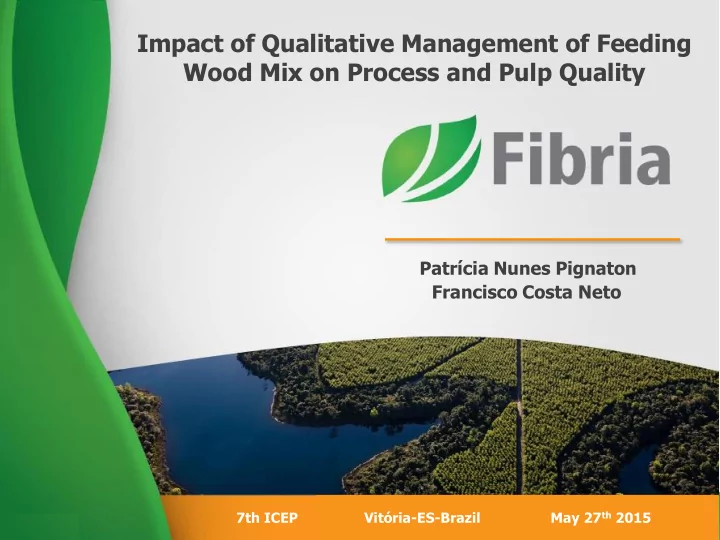

Impact of Qualitative Management of Feeding Wood Mix on Process and Pulp Quality Impact of qualitative management of feeding wood mix on the process and pulp quality Patrícia Nunes Pignaton Patrícia Nunes Pignaton Francisco Costa Neto Francisco Costa Neto Fibria Celulose S.A., Brazil Vitória-ES, Brazil 7th ICEP Vitória-ES-Brazil May 27 th 2015 May 27 th , 2015
INTRODUCTION This presentation summarizes the experience over the last 3-years on qualitative wood supply management at Fibria Aracruz Unit - a complex of three pulp Mills. The aim of this management is to supply the Mill with the lowest wood density standard deviation feasible and consequently to reduce variability on process and pulp quality. Fibria’s Operations Fibria Aracruz Unit 7th ICEP I Vitória-ES, Brazil I May 27 th ■ 2015
INTRODUCTION WHY to implement a qualitative management of the feeding wood? Wood is the key raw material in terms of pulp quality, production cost and process productivity. So industry strategy in terms of wood quality will certainly changes with time! Industry continuous searching process ... impacts the forestry density for the “best” wood supply ... variability. As a consequence: - researches for the best “ pulpability ” wood - a feeding wood mix with high density standard deviation impacts process - market demands selectivity (different density demands - land related issues different strategies at the impregnation and cooking process) - cost reduction strategies - new projects installations, etc - a feeding wood mix that changes significantly within a short time results in process and consequently quality variability. 7th ICEP I Vitória-ES, Brazil I May 27 th ■ 2015
INTRODUCTION Density Prediction Model – the basis for the qualitative management Wood density can be predicted by a model that considers the interaction of genotype x growing environmental x age. Density predicted information available for wood supply planning area Density Prediction Model Inputs Density predicted control Harvesting age Genotype Environmental 7th ICEP I Vitória-ES, Brazil I May 27 th ■ 2015
The Mill Experience Qualitative management of feeding wood mix – Fibria Celulose SA – Aracruz Unit Premisses: - key wood quality parameter: Density standard deviation – weekly supply each Mill with an SD lower than the SD of wood mix - Wood harvested classified in 3 different density classes ( low, medium, high ) 7th ICEP I Vitória-ES, Brazil I May 27 th ■ 2015
The Mill Experience 7th ICEP I Vitória-ES, Brazil I May 27 th ■ 2015
The Mill Experience - RESULTS Feeding wood mix Density SD average reduction of 10 points before After implementation before After implementation 7th ICEP I Vitória-ES, Brazil I May 27 th ■ 2015
The Mill Experience - RESULTS Confirmed Process Selectivity x Density SD Process selectivity is considered an indicator for process yield and pulp quality, since it confirms the degrees of fibers preservation. It can be calculated as a ratio between pulp viscosity and digester kappa number. 7th ICEP I Vitória-ES, Brazil I May 27 th ■ 2015
The Mill Experience - RESULTS WSC – Wood Specific Consumption – a reduction of 3% (mass based) Before After implementation 7th ICEP I Vitória-ES, Brazil I May 27 th ■ 2015
The Mill Experience - RESULTS Pulp quality – tensile improves 10% when decreasing 30% of density SD (compared at the same digester kappa level and similar density level) 7th ICEP I Vitória-ES, Brazil I May 27 th ■ 2015
The Mill Experience - RESULTS Chalenges for the Quality Management operation - Complex control for wood supply area: hard planning but none extra cost on operations (a premisse) - Wood density model continuous update 7th ICEP I Vitória-ES, Brazil I May 27 th ■ 2015
CONCLUSIONS - All the efforts on reducing standard deviation of feeding wood mix result in a noticeable positive impacts on process selectivity and stability, quality and wood cost. - The model is consolidated as a successful and useful tool for the wood supply area - Control is complex but feasible and demands a high compromising from the forestry area and a good partnership and alignment between industry and forestry areas. - The next steps for evolves on this quality management: - implementation of the on going density model revision - for 2016 the concept of low SD density of wood supply is being included as a restriction at the medium and long term forestry planning simulation system, in order to generate an annually harvest plan aligned with this successful strategy and consequently demanding less efforts over the short term wood supply area - evolves even more on this process in order to achive a SD as close as possible to the ideal number of 25 7th ICEP I Vitória-ES, Brazil I May 27 th ■ 2015
REFERENCES CLAUDIO-DA-SILVA, JR.E., A influência da densidade básica da madeira de híbridos de Eucalyptus Grandis em suas características químicas e propriedades de polpação e do papel , 18º Congresso Anual da ABCP - Semana do Papel, São Paulo, Brasil, (1985). Colodette J.L., et al, The Importance of Eucalyptus Wood Density and Chemisty on Eucalyptus Clone Selection, (2015). DOWNES, G.M. et al., Sampling plantation eucalypts for wood and fibre properties, CSIRO, Melbourne, Australia, (1997). QUEIROZ, S. C. S. et al, Influência da densidade básica da madeira na qualidade da polpa Kraft de clones híbridos de Eucalyptus grandis x Eucalyptus urophylla . Revista Árvore, v. 28, n. 6, p.901- 909, (2004). SILVA, J. et al, Importância do eucalipto para a indústria de celulose no Brasil . Revista de madeira, Curitiba, p.90-92, Suplemento especial, (2001). THIERSCH, C.R. et al. Uso de modelos matemáticos na estimativa da densidade básica da madeira em plantios de clones de Eucalyptus sp . Revista Cerne, Lavras, v. 12, n. 3, p. 264-278, jul./set, (2006).
Acknowledgements To all Fibria professionals involved and responsible for the implementation and operation of the Wood Quality Management (Forestry: Luiz Geraldo, Francisco, Bruno and Amarildo; Industry: Wanderlei , Cristiano and Edson Hélio). THANK YOU! pnunes@fibria.com.br fcn@fibria.com.br
Recommend
More recommend